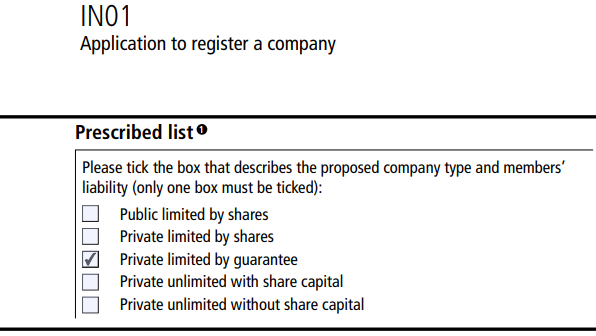A company limited by guarantee is a not-for-profit business set up to serve social, charitable, community-based or other non-commercial objectives. Rather than distribute profits to members, guarantee companies typically retain any surplus income for reinvestment or use it to promote the non-profit objectives of the business. The company limited by guarantee model is most often used by clubs, co-operatives, social enterprises, community projects, membership organisations and charities. Some community interest companies (CICs) are guarantee companies, though they don’t have to be.
A private company limited by guarantee is in many ways just like an ordinary private company limited by shares:
- It’s a separate legal entity. It can enter into contracts, have bank accounts, sue and be sued, and so on, as if it were a person.
- It provides limited liability. The directors cannot usually be pursued personally for debts and liabilities incurred by the company.
- It is incorporated at and regulated by Companies House and subject to the Companies Acts. If the company is charitable, it will also be subject to charity law and be regulated by the Charity Commission or, in Scotland, the OSCR.
- It is subject to rules on its name. Although they must typically include the suffix ‘Limited’ or ‘Ltd’ in their names, there is an exemption available from this requirement. That is where the company is set up for certain objects and does not distribute its profits to members.
- It requires both a Memorandum and Articles of Association. The articles of a company limited by guarantee will often contain a list of predetermined objects, defining what the company will do. They’ll also often contain a specific clause restricting the payment of any profits to members. The articles will instead direct the reinvestment of surplus income to further the company’s objects.
- It must have a registered office address based in the country of incorporation.
- It must register its annual accounts.
- It must submit a confirmation statement to Companies House and make various other filings when certain events occur, for example the appointment of a director or a change of address.
- It must maintain certain statutory registers such as a register of members and a PSC (persons with significant control) register.
What’s different about a company limited by guarantee?
A company limited by guarantee does not have shareholders or share capital. Instead, it has guarantors, popularly called ‘members’. Their personal liability is limited to their ‘guarantee’: an amount they agree to contribute towards the company’s liabilities. This will only come into play if the company is unable to pay bills or is wound up. The guarantee amount is usually nominal, the most common figure being £1. Except in cases of fraud or negligence, the liability of individual members is strictly limited.
A company limited by guarantee does not have shareholders or share capital. Instead, it has guarantors, popularly called ‘members’. Their personal liability is limited to their ‘guarantee’: an amount they agree to contribute towards the company’s liabilities.
A guarantor member of a company limited by guarantee can be a person or a corporate body. The company must have at least one member and, unless the company’s articles of association state otherwise, there’s no maximum limit. Many membership organisations set up as companies limited by guarantee have thousands of members, far beyond the average company limited by shares. Unless membership is completely closed, the company will need a process for accepting new members.
The guarantor members of a company limited by guarantee exercise overall control upon the company. This is in much the same way as shareholders control a company limited by shares. They do not ‘own’ the company in quite the same sense and generally have no rights to profits from it. But they do control any changes to its constitution and will influence the most important decisions made in its name. For a little more detail about how members and shareholders are ‘the same but different’, please see our article Shareholder vs. member: what’s the difference?
The first members (known as ‘subscribers’) of a company limited by guarantee must be reported to Companies House. However, after that there is no need to report to Companies House any changes in membership or the identities of new members. That said, it is still a requirement for the company to maintain an up to date register of members, which should be available for inspection.
In other articles, we look at the process of admitting new members and the requirement for membership certificates of a company limited by guarantee.
Who runs a company limited by guarantee?
The members must appoint one or more directors to manage day-to-day operations. All companies must have at least one director, while companies set up for charitable purposes typically require at least two. There’s nothing to stop members also being directors.
Often, the directors of companies limited by guarantee geared towards certain purposes will be given some other title. Charities often call them trustees, schools usually call them governors and in other cases they may be termed committee members. In a residents’ management company, the directors might collectively be the management committee, or in other organisations be termed the board of managers. Whatever title they are given, if they exercise day to day control over the company they remain directors of it. It’s important to ensure that each individual who assumes the role of director is properly appointed and fully aware of their duties.
As in other types of company, the role of the directors includes a legal responsibility to promote the success of the company. Their exact powers will depend on the contents of the company’s articles of association, but will typically be broadly defined. Powers are usually conferred on the board of directors collectively, who may then choose to delegate them. They may, for example, set up sub-committees on certain subjects or allocate specific responsibilities to individual directors. An example of this might be a treasurer or membership secretary.
Whatever title they are given, if they exercise day to day control over the company they remain directors of it. It’s important to ensure that each individual who assumes the role of director is properly appointed and fully aware of their duties.
Members typically appoint the directors and, likewise, have the right to remove a director by ordinary resolution. In some companies, however, some or perhaps all of the directors may be appointed by external organisations with an interest in the company or its objects. This might include external backers like local authorities, unions or charities.
The initial directors of a company limited by guarantee must be reported to Companies House when the company is formed. Thereafter, each new appointment, change in details or termination of an existing appointment must similarly be reported. The members may choose to appoint a company secretary, although in general there’s no legal requirement to do so.
How is a company limited by guarantee financed?
As a company limited by guarantee doesn’t have share capital, it cannot raise money by issuing shares. This generally makes them more suitable as non-profit ventures. However, they can pursue their object by securing funds via grants or borrowing – for example by issuing debentures. Many membership organisations set up as companies limited by guarantee impose annual subscriptions or joining fees to cover running costs.
The company’s articles of association will often preclude the distribution of profits.
The 2006 Companies Act does not specifically prevent a company limited by guarantee from distributing surplus income to members. In fact, a small number of guarantee companies do so. However, in the majority of cases any profit is retained by the company to advance the aims of the organisation.
As a company limited by guarantee doesn’t have share capital, it cannot raise money by issuing shares. This generally makes them more suitable as non-profit ventures.
The company’s articles of association will often preclude the distribution of profits. Furthermore, if members receive a share of profits from a company set up for charitable purposes the company will sacrifice its right to charitable status.
A company limited by guarantee must file accounts and tax returns to the same deadlines as a company limited by shares. The main differences to the accounts are that:
- There will be no share capital on the balance sheet
- Different terminology is typically used, alongside a note that the company is limited by guarantee. ‘Profit’ should instead be termed ‘Surplus’ and ‘Shareholders Funds’ should be replaced by ‘Reserves’.
There will be other requirements for certain types of companies limited by guarantee. In particular, any charitable company will also need to comply with the requirements of the Charity Commission or OSCR.
Inform Direct helps you keep up to date records for a company limited by guarantee. File annual accounts, confirmation statements, officer and PSC updates directly with Companies House.
This article was originally published in 2015. The most recent update was on 25 September 2023.



thanks for the information